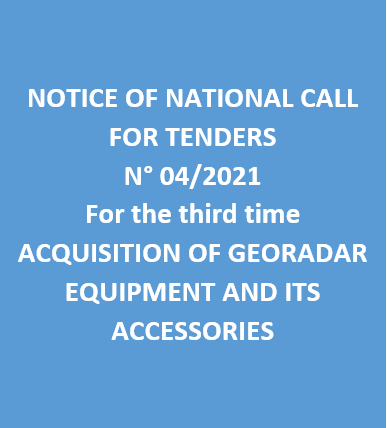| Annual program and technical progress report |
-

Activity Report 2023
-

Technical Program 2024
|
| Geocatalogue |

|
| Invitation to
tender |
-

REALIZATION OF THE TRAINING PLAN FOR THE YEAR 2022
-

ACQUISITION OF TWO SERVICE CARS
-

ACQUISITION OF GEORADAR EQUIPMENT AND ITS ACCESSORIES
|
|
Invest in Tunisia |

|
|
|
|
|
::
Documentation and Editions
>>
Research library
|
| |
|
[
Search by author
]
[
Search keyword
]
[
Search by index
]
[
Search by category
]
|
title of the reference :
|
The Reineche member Cercina field, offshore Tunisia
|
|
Publication Date:
|
1994
|
|
Author :
|
Ratcliffe K.T., Petty D., Alderton J. K.
|
|
Catalogue type :
|
Livre
|
|
Catalogue reference :
|
The Reineche member Cercina field, offshore Tunisia a diagenetically enhanced hydrocarbon resevoir "The Reineche Member is a proven hydrocarbon reservoir in the Cercian Field, offshore Tunisia.The play was discovred by British Gas in Febrary 1992 and represent the first recorded hydrocarbon find in the nummulitique limestones of the Reineche Member. The limmstones that comprise the Reienche Member are sundwitched betwen the thick, claystones-dominaited, cherahil ""A"" and Cherahil ""B"" Formations and are of the Middle Eocene age. The nummilitic limestone have well developped porosity in the form of both intraparticle and interparticle pores. The formel occur within nummulite chambers and can account for a hight persentage of rock volume, but remene non-effective unless compactional fracturing breaches the nummulite walls. The interparticle pores are in the form of small irregular vugs which are mostly associeted with areas of matrix but occasionally impringe upon the bioclastes. These pores vary in size from a few microns to several millimetres. The micropores can be pervasive throughout the interparticle areas producing a friable, highly porous sediment. Petrographic, scanning electron microscope, cathodoluminescence and stable isotope studies of those limestones indicate that the unit has been subjected to multiple periods of dissolution, calcite precipitation and dolomitisation. Such features are most commonly associated with the freshwater phreatic diagenitic environment. However, the Reineche Member displays no evidence of the extensive subaereal exposure necessary to create to dissolutional effects seen in the limestones. Addionally, there is no lightening of the oxygen isotopes that is associated with meteoric diagenesis. Therefore, while a meteoric influence is not completely excluded, it is believed that other processes are required to produce the higher percentage of dissolution-related pore space within the Reineche Member. Understanding these processes to be paramount in being able to predict porosity variation within the Reineche Member of the Cercina Field."
offshore ; Eocène ; pétrole ; gaz naturel ; roche mère hydrocarbure ; biostratigraphie ; diagenèse ; pétrographie ; silicification ; dolomitisation ; Tunisie ; Tunisie Sud Orientale ; Kerkennah Petty D. Alderton J. K. Ratcliffe K.T. Gîtologie
|
|
Indexation decimale :
|
Gîtologie
|
|
Keywords :
|
offshore ; Eocène ; pétrole ; gaz naturel ; roche mère hydrocarbure ; biostratigraphie ; diagenèse ; pétrographie ; silicification ; dolomitisation ; Tunisie ; Tunisie Sud Orientale ; Kerkennah
|
|
Summary :
|
"The Reineche Member is a proven hydrocarbon reservoir in the Cercian Field, offshore Tunisia.The play was discovred by British Gas in Febrary 1992 and represent the first recorded hydrocarbon find in the nummulitique limestones of the Reineche Member. The limmstones that comprise the Reienche Member are sundwitched betwen the thick, claystones-dominaited, cherahil ""A"" and Cherahil ""B"" Formations and are of the Middle Eocene age. The nummilitic limestone have well developped porosity in the form of both intraparticle and interparticle pores. The formel occur within nummulite chambers and can account for a hight persentage of rock volume, but remene non-effective unless compactional fracturing breaches the nummulite walls. The interparticle pores are in the form of small irregular vugs which are mostly associeted with areas of matrix but occasionally impringe upon the bioclastes. These pores vary in size from a few microns to several millimetres. The micropores can be pervasive throughout the interparticle areas producing a friable, highly porous sediment. Petrographic, scanning electron microscope, cathodoluminescence and stable isotope studies of those limestones indicate that the unit has been subjected to multiple periods of dissolution, calcite precipitation and dolomitisation. Such features are most commonly associated with the freshwater phreatic diagenitic environment. However, the Reineche Member displays no evidence of the extensive subaereal exposure necessary to create to dissolutional effects seen in the limestones. Addionally, there is no lightening of the oxygen isotopes that is associated with meteoric diagenesis. Therefore, while a meteoric influence is not completely excluded, it is believed that other processes are required to produce the higher percentage of dissolution-related pore space within the Reineche Member. Understanding these processes to be paramount in being able to predict porosity variation within the Reineche Member of the Cercina Field."
|
|
Exemplaries :
|
-
|
|
|
|
|
|
|
|



